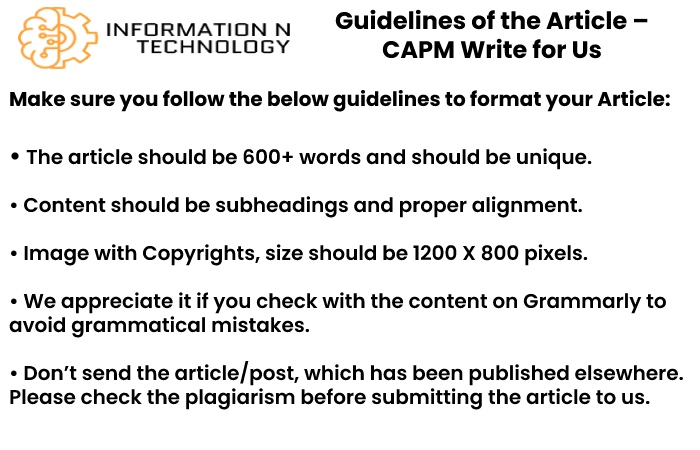CAPM Write For Us
CAPM write for us – informationntechnology.com offers an exciting guest posting platform, providing a dynamic space for writers and experts to share their ideas with an audience. Moreover, as a reputable online publication, informationntechnology.com covers a number of topics, making it an ideal space for contributors from many fields to showcase their expertise. informationntechnology is a guest posting website not only allows authors to reach a number of audience, but also provides the chance to relate with a community of like-minded people.
The informationntechnology.com editorial team values high-quality content that is informative, educational, well-researched and relevant to its readers. Whether you are an industry professional, thought leader, or emerging talent, contributing to informationntechnology.com allows you to establish credibility and visibility in your niche. The platform’s commitment to excellence ensures that guest contributors receive the recognition they deserve while contributing valuable perspectives to an engaged audience.
We invite writers who want to grow their businesses and established businesses to contribute to our topic’s websites.
Please share your thoughts; we are looking forward to working with you contact@informationntechnology.com.
How to Submit Your Articles?
To submit your article at informationntechnology.com, you can send an email or pitch us at contact@informationntechnology.com.
What is a CAPM?
Basically, the capital market theory is an economic theory about the valuation of assets that explains how the prices of securities are determined in financial markets.
On the other hand, the contribution Fundamental to this theory is the equilibrium price model of financial assets (CAPM), which tries to find a balance between profitability and risk for securities or portfolios of titles.
Capital market theory starts from very restrictive assumptions, adopts some of the hypotheses of the mean-variance model to which other hypotheses added:
– Investors make their decisions in terms of expected return and risk, according to a rational behavior
– All investors have the same time horizon
– Expectations are infinitely divisible
– The markets are efficient. Prices reflect all available information and adjusted quickly to new information
– There are no taxes or transaction costs
– The risk-free interest rate is the same for all investors and the same for the loan and the indebtedness
The market model
That is to say, the approach presented by Markowitz forms the basis of modern portfolio theory, based on the which have developed a series of models that try to overcome the difficulties of applying yourself and complete the basic theory.
Sharpe (1963) and Treynor (1965) develop an approach known as the “market model.” The Analysis of the variations in the prices of the securities reveals that most of them tend to move up or down at the same time and in the same direction as the market, measured by the evolution of the market through one of the available stock indices.
Financial Management ADE
On the other hand, this suggests that the observed correlation between security returns is due, in part, to their relation to a series of common factors that, according to Sharpe, can be represented by market performance. Thus, the performance of a title can be expressed by the following equation:
Rj = j + jRm + j
moreover, Where Rj is the performance of title j, Rm is the market performance measured against an index j is constant called the volatility coefficient that measures the expected changes in Rj in the function of the variations in Rm.
J is the independent term of the regression j is the random term that represents the residual error in the estimation of performance. In other words, It is assumed that j is independent of the regressor Rm and its mean value is E [j] = 0.
Variations in the performance of security divided into two components, a variation systematic, jRm, due to market changes, and a unique component, j + j, in relation to the specific characteristics of the title.
If we take into account the existence of risk-free assets, we can express the above relationship in terms of a security’s excess return over the risk-free rate (Rf) or risk premium.
Rj – Rf = j + j (Rm – Rf) + j
This expression is known as a “characteristic line,” although the actual performance of the securities may not coinciding with the one determined according to the characteristic line because of the random error. His graphic representation is as follows:
(Graph – characteristic line)
Each point on the graph represents the excess of the return of an asset over the free interest of risk in a period of time in relation to the performance of the market during the same period.
The dispersion of the points with respect to the characteristic line expresses the part of the attributable yield to the specific characteristics of the title. The slope of the line coincides with the beta coefficient ofvolatility.
The coefficient measures the sensitivity of a security’s return to market performance.
The yield of the security varies more than proportionally than the yield of the market.
Why Write for informationntechnology – CAPM Write for Us
Search Related Terms to CAMP Write for Us
- Capital Market
- Theory
- Economic Theory
- Valuation
- Securities
- Financial Markets
- Fundamental
- Equilibrium Price Model
- Financial Assets
- Variance Model
- Investors
- Markets
- Transaction Costs
- Modern Portfolio Theory
- Residual Error
- Risk-Free Assets
- Characteristic Line
- Unique Component
- Camp
- Security’s Excess
Search Terms for CAMP Write for Us
- CAMP Guest Post
- CAMP Write For Us
- Contribute CAMP
- CAMP Submit Post
- CAMP: Submit An Article.
- Become A Guest Blogger For CAMP.
- CAMP Writers Wanted
- CAMP Suggests A Post.
- Guest Author CAMP
- CAMP + “Write For Us”
- CAMP “Guest Post
- CAMP “Write For Us”
- CAMP “Guest Article”
- CAMP “Guest Post Opportunities”
- CAMP “Looking For Guest Posts”
- CAMP “Contributing Writer”
- CAMP “Want To Write For”
- CAMP “Submit Blog Post”
- CAMP “Contribute To Our Site”
- CAMP “Submit Face Book Ads”
- CAMP “Submit Face Book Ads”
- CAMP “Guest Posting Guidelines”
- CAMP “Suggest A Post”
- CAMP “Submit An Article”
- CAMP “Contributor Guidelines”
- CAMP “Contributing Writer”
- CAMP “Submit News”
- CAMP “Submit Post”
- CAMP “Become A Guest Blogger
- CAMP “Guest Blogger”
- CAMP “Guest Poster Wanted”
- CAMP “Accepting Guest Posts”
- CAMP “Writers Wanted”
- CAMP “Articles Wanted”
- CAMP “Become An Author”
- CAMP “Become Guest Writer”
- CAMP “Become A Contributor”
- CAMP “Submit Guest Post”
- CAMP “Submit An Article”
- CAMP “Submit Article”
- CAMP “Guest Author”



